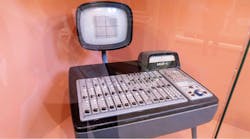Few joys in the music world can compare to the sound of a vintage analog Hammond B3 electric organ in its full, rich splendor. Originally designed as a portable alternative to very nonportable church or theatre organs, the Hammond B3 came into its own on hundreds of popular recordings in the 1950s and 1960s. Just listen to any number of 1960s surf and blues classics, for example. Or even better, check out the late, great jazz organist and bandleader, Jimmy Smith, in his late 1950s and early 1960s recordings for the Blue Note and Verve labels.
Those older Hammond B3 tone-wheel organs, which were among the most popular electric organs ever built, are getting harder to come by these days. But musicians still want that vintage Jimmy Smith sound. Fortunately, CreamWare has produced sound modules that enable users of modern digital music synthesizers to emulate the sound and feel of the B3, as well as several other popular and legendary analog keyboards, using SHARC DSPs from Analog Devices.
The B4000 ASB, Creamware’s most recent design, uses the precision of the floating-point SHARC 2126x and 2136x DSPs to replicate the analog circuitry of the Hammond B3 organ. CreamWare is now about to release its Prodyssey ASB, a replica of the famous ARP Odyssey synthesizer, which also will use the SHARC processor.
CreamWare’s prior releases, the MiniMax and Pro-12, use SHARCs to faithfully recreate every nuance of the legends they’re based on (the MiniMoog and Prophet-5, respectively). Yet they also add new, modern digital features like preset storage, expanded polyphony, MIDI control, and effects.
Thanks to the SHARC DSPs’ 32-bit floating-point precision and 40-bit floating-point resolution, CreamWare was able to implement sophisticated algorithms in creating its latest sound modules. CreamWare took advantage of the SHARC DSPs’ wealth of I/O and memory as well as Crosscore development tools.
The SHARC DSPs’ audio processors integrate audio-specific peripherals, called digital audio interfaces (DAIs), that simplify hardware design, minimize design risks, and quicken time-to-market. These peripheral blocks may be connected to each other or to external pins via the software-programmable signal routing unit (SRU), an architectural feature that enables complete and flexible routing among DAI peripherals.
CreamWare also used Analog Devices’ emulators and the VisualDSP++ integrated development and debugging environment (IDDE). The VisualDSP++ IDDE lets programmers develop and debug an application.
Analog Devices
www.analog.com


